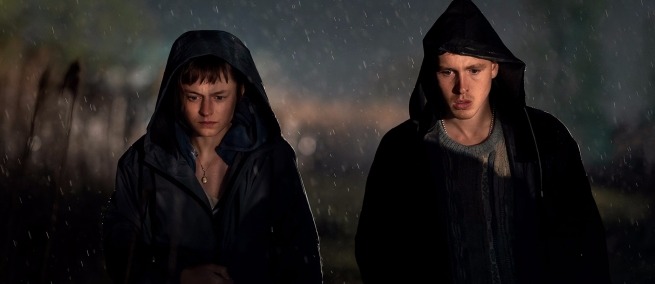
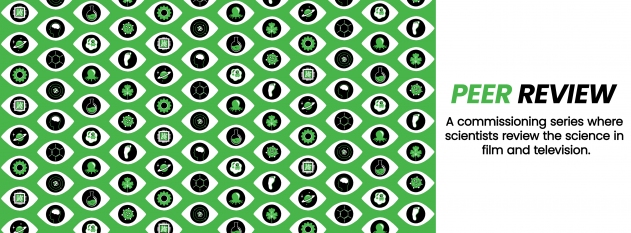
Please note: This article contains spoilers.
A MURDER AT THE END OF THE WORLD is an FX/Hulu miniseries (seven episodes, each about 40 minutes). The lead, Darby Hart, is played by Emma Corrin. Among the supporting cast are Joan Chen (cast as Lu Mei), Harris Dickinson (as Bill Farrah), Clive Owen (as Andy Ronson, a character whose role increases as the series progresses), and Brit Marling (one of the show’s creators and producers, as Lee Andersen).
Darby is a hacker who got her start by uncovering the identity of a serial killer, and then writing a book about it. Her father was the coroner in a small Iowa county; at one point Darby says “this is my 57th crime scene.” In her investigations she worked with her boyfriend Bill Farrah. The opening of the series has Darby reading from her book. (The series closes with her reading from her second book about the experiences of the miniseries.) There are extended flashbacks throughout the series to Darby and Bill in their earlier work trying to trace the footsteps of the serial killer and uncover their identity, with the help of an online community of amateur sleuths.
I admit that I am not of the generation that produces modern hackers, but I have taught enough university students recently to feel I can comment on them. Women are rare in that world. There is a huge gender gap in computing, and there are several studies of how that affects the software that–increasingly–will dominate and direct our lives. The gender issues in the world of computing are well known to those of us who live there, but it seems hard to figure out why the issues exist and harder yet to know how to change things. (This is not culture-war material; with the huge shortage of computing talent to be hired, the inability to draw equally from both men and women means that the shortage will likely continue, and computing will thus continue to be done badly due to the talent shortage.)
The basic plot of A MURDER AT THE END OF THE WORLD is that a zillionaire tech mogul (Andy Ronson) brings eight people to a secluded “retreat” in Iceland (the end of the world of the show title) for undisclosed purposes. What follows is in part a standard plot (seclusion, storm, isolation, megalomania, shades of Agatha Christie). Three are found dead, but under circumstances that can’t quite be called murder. The first of the dead is Darby’s old boyfriend Bill, who has become a famous artist critiquing technology. The rest of the series is about determining who did what and why.
Bill dies first.
I think the series starts really well, with tension and foreshadowing. It lags a little in the middle episodes (perhaps the seven episodes could have been cut to five?), but Darby is compelling throughout. The others are less so (at least not to this reviewer) until the very end when Ronson and Andersen take on larger roles.
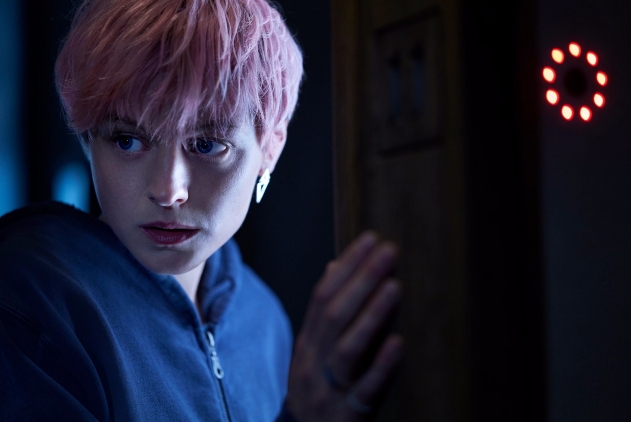
Emma Corrin as Darby Hart. Image courtesy of FX.
Although the series involves some depictions of hacking, it is more focused on surveillance technology, with an undercurrent that software is almost certainly fragile. Software cannot be assumed to be secure against malicious hackers, and we should be very wary of software that makes “policy” decisions about human beings without concurrence by humans with discernment. The setting of the show, a retreat in Iceland, is under complete surveillance—think Hal 9000 from 2001: A SPACE ODYSSEY, but now with a holographic presence named “Ray.” Ray has total awareness of what’s going on, and fifty years of advances in computing. (Think back to 2001: “Dave, I can’t do that.”) At one point, Darby hacks the cameras at the resort. She and Lee (a renowned former hacker, somewhat on the run from the authorities, and someone Darby looks up to) combine forces. The real geek-speak is somewhat minimal, but the discussions about passwords, network IDs, and Ray’s surveillance permeate Darby’s attempts to understand what has really happened at the resort. When Darby is confronted with another of the guests, she asks “Are you ‘vi’ or ‘emacs’?” When the answer is a blank stare, Darby knows her visitor isn’t a hacker (and is thus not threatening on a computing front). (Non-geeks will probably miss this: These are the two major editors used by programmers; I use ‘vi’.)
Ray is a program that monitors everything inside the retreat and can be represented via holography as if “he” were a person. Towards the end of the show it is suggested that one reason for the retreat is to market Ray to Lu Mei, who works on the creation/development of smart cities. There are some comments about technology that are dead-on. Lu Mei says that “The future of everything is in collaboration with artificial intelligence.” Ronson then puts in his two cents: “I prefer the term ‘alternative intelligence.’” Lu Mei might be wrong, but her comment is enormously contentious today and will continue to be so. A large part of what we will do in the (even near) future will be assisted by, or skewed by, the AI/alternative intelligence of Chat, of Siri, of even things as simple as Google searches. It is already the case that we turn to the internet for answers to questions of fact. It’s maybe only three or four years from now until we might ask for more than just factoid responses. At what point will AI responses be more than just for family room discussions and responses upon which policy actions rely? What is really needed is a greater awareness that what is coming back from the computer needs to be vetted, if what is coming back is going to affect what happens in the lives of people. AI is great when it works, but it isn’t perfect yet, and we need to vet what we get from AI in several areas.
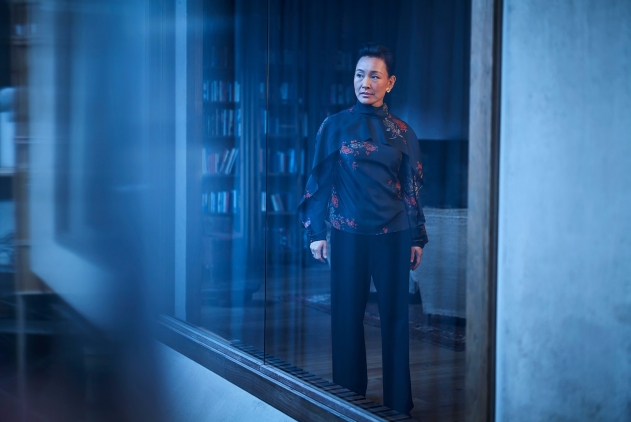
Joan Chen as Lu Mei. Image courtesy of FX.
With tools like facial recognition, AI-generated text and art, and extensive surveillance, the capabilities and the constraints on the power of AI creations like “Ray” are going to be debated for several years. Ray, as presented in the series, is perhaps ten years away. The danger is that a flawed and incomplete prototype version of Ray could be permitted five years from now to affect what we do, or could do. Those shiny new objects could very likely have some sharp edges.
There is also a major undercurrent in the series about power. Ronson has an empire, and funds, and is intent on building more. Darby (and towards the end Lee) demonstrates that there are flaws in the software that those with less power could find and use to their advantage. There are likely always flaws in large software programs, and Darby and Lee demonstrate that even Ray has flaws that can be found, and then exploited, by those not necessarily less capable but certainly not part of the original team producing the software. It has long been my belief that the reason we have so much bad software is that there is no commercial advantage to getting software rock solid “right.” The advantage is to have a “something” six months ahead of the competition, and a plausible statement about updates when flaws are found. I have often said the test of an iPad app is a four-year-old. They will know that things can happen, and will push buttons expecting something to happen. If the app freezes from too many random buttons, it needs to be fixed. The apps need to be robust even when tried by a four-year-old. They need to recover from this type of behavior, and they usually cannot. The same can be said for Ray. “He” can “do,” provided what he is asked to “do” is within what “his” programming dictates. Go outside those bounds, and all bets are off.
The show’s conclusion is worth the wait; it is totally relevant to what we are experiencing and debating in policy and seeing in the news. Can we believe that the software will do only and exactly what we think we have written it to do? Have we overlooked things that could happen that go beyond what we thought we had coded into the program? Are we unaware of what could happen because we did not properly limit what the software could do? These are the basic questions about AI in the real world.
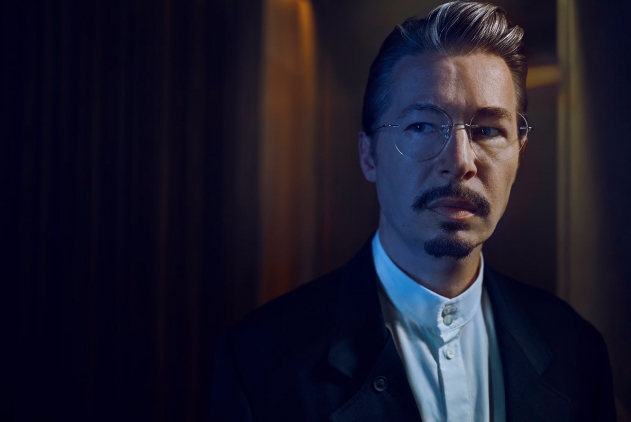
Edoardo Ballerini as Ray. Image courtesy of FX.
The British writer Charles Stross wrote science fiction about technology “just a little bit out there.” Stross has apparently quit writing his science fiction because he feels it is no longer “fiction.” This series has the same feel. Stross wrote books about a woman detective in Edinburgh, Scotland, who would sit in the coffee shop with her CopSpace glasses giving her virtual/augmented reality, and her haptic ability to see or change things with a literal wave of her hands. That technology isn’t here now (except in the labs), but it’s only a very small number of years away.
This series ends in the same vein as one of Stross’s stories. I will foreshadow the end in saying that we get an understanding of where we need to create boundaries for what software “can” do for us and what it “should” do for us. It’s not clear how we create those boundaries, and it’s not clear how we demonstrate that we have covered all the moral and ethical bases in the writing of the software. The “alternative intelligence” of Ray, the program that monitors everything, is clearly just around the corner—for good or for ill.
I recommend the series. Hang in there for the middle episodes, and be aware that the ending is may seem conclusive but does not fully resolve the issues that arise. As I was told long ago by my department chair, “A system is only as good as its backup.” The absence of backups makes for simpler television, but is probably not what we have in the real world. The Ray as “he” exists in the retreat is eventually brought under control, but it would be foolish to think, especially in these days of cloud computing, that something as capable as Ray would only exist inside the retreat.
♦
TOPICS